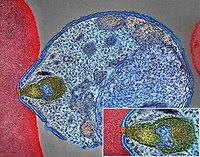
Photo from wikipedia
BackgroundMany of the mosquito species responsible for malaria transmission belong to a sibling complex; a taxonomic group of morphologically identical, closely related species. Sibling species often differ in several important… Click to show full abstract
BackgroundMany of the mosquito species responsible for malaria transmission belong to a sibling complex; a taxonomic group of morphologically identical, closely related species. Sibling species often differ in several important factors that have the potential to impact malaria control, including their geographical distribution, resistance to insecticides, biting and resting locations, and host preference. The aim of this study was to define the geographical distributions of dominant malaria vector sibling species in Africa so these distributions can be coupled with data on key factors such as insecticide resistance to aid more focussed, species-selective vector control.ResultsWithin the Anopheles gambiae species complex and the Anopheles funestus subgroup, predicted geographical distributions for Anopheles coluzzii, An. gambiae (as now defined) and An. funestus (distinct from the subgroup) have been produced for the first time. Improved predicted geographical distributions for Anopheles arabiensis, Anopheles melas and Anopheles merus have been generated based on records that were confirmed using molecular identification methods and a model that addresses issues of sampling bias and past changes to the environment. The data available for insecticide resistance has been evaluated and differences between sibling species are apparent although further analysis is required to elucidate trends in resistance.ConclusionsSibling species display important variability in their geographical distributions and the most important malaria vector sibling species in Africa have been mapped here for the first time. This will allow geographical occurrence data to be coupled with species-specific data on important factors for vector control including insecticide resistance. Species-specific data on insecticide resistance is available for the most important malaria vectors in Africa, namely An. arabiensis, An. coluzzii, An. gambiae and An. funestus. Future work to combine these data with the geographical distributions mapped here will allow more focussed and resource-efficient vector control and provide information to greatly improve and inform existing malaria transmission models.
Journal Title: Malaria Journal
Year Published: 2017
Link to full text (if available)
Share on Social Media: Sign Up to like & get
recommendations!